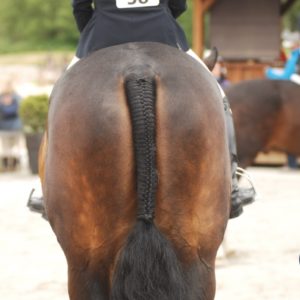The first time that I competed seriously to make a team was in 1983.
I was trying out for the Pan American Games on a Grand Prix horse called Romantico. That year, it was a Prix St. George test for the team medal and an Intermediare II test for the individual medal. But you basically had to be on a Grand Prix horse to make the podium. It was a strange time.
To qualify for the team, the United States Equestrian Team (USET) held two selection trials over two weekends at its Gladstone headquarters in New Jersey.
I had been doing really well with Romantico. I went in very confident. At the end of the trials, the judges told me I had won or was at least comparable to our great Olympian at that time, Hilda Gurney.
I was a shoo-in for the team. I Felt certain of it.
I was a shoo-in for the team. I felt certain of it.
It didn’t hurt my cause that George Theodorescu was the team coach at the time and my personal trainer. I felt confident that he thought I was a strong contender for the Team. I was a kid still. Naive.
You couldn’t know for sure though until it was announced. Back then, US team selections were completely subjective. There was no objective set of criteria that you could read and say, “Okay, I’m ranked here, therefore, I know that I’m going.” You’d find out who made the team when Billy Steinkraus, then USET president, marched us all up the stairs of the rotunda at Gladstone and made the announcement.
So there we are, all lined up, as Billy Steinkraus starts to read off the names. I’m thinking, I’m ready, I’m ready!
“And the first person on the team is Hilda Guerney.”
I thought, Oh that’s great! I’ll be on a team with Hilda.
“And the second name is…” I’m waiting, “Kay Meredith.”
I thought, Oh, fabulous. I love Kay!
“And the third name is…Edith Masters.”
It was a three-rider team back then, with a reserve. I thought, Okay, I’ll be the travelling reserve. I’ll be happy with that.
“And the fourth name is—”
Not me.
I wasn’t even the second reserve. I wasn’t named to the team at all.
When I heard the last rider’s name called, I thought, Wait a minute. I got more points just in the trot than what she could do in an entire test with this horse!
I remember going back to my room at Gladstone, laying on the bed, and just bawling. Devastated.
Ten minutes later, there was a knock on my door and Kay Meredith came in. She said, “You know, Robert, you’re not going to understand this and I want you know that you deserve to be on the team, but the forces that have kept you off the team have nothing to do with how you rode. You’re not going to know it, you may never know, but the truth had nothing to do with why you are not on the team.”
She hugged me and left.
I didn’t know what she meant. I just knew I never wanted to feel like that again.
It was a huge life changing moment for me.
I went home from Gladstone and decided that I would never again base my happiness on making or not making the team. I’m going to be a happy human being. I’m going to love my life, and if I do a good job, I’ll make a team. And if I don’t do a good job, I’m still going to be happy.
It was a huge life changing moment for me.
One year later, 1984 came. Not only did I win the Olympic Trials, I went to the Olympics.
George Theodorescu was our coach again that year. He told me after the Selection Trials that he kept me off the Pan American team because he didn’t want the judges to see my horse doing a Prix St. George test the year before the Olympics. That test is all about gaits and long lines. Romantico didn’t have a great walk or even a great canter. But he did the hardest moves of the Grand Prix really well.
George was strategically trying to prevent my horse from being seen on the international level the year before the Games but did not recognize how this decision might affect me or my confidence as a rider.
Looking back, I have definitely made some of my biggest mistakes by disregarding my gut instincts and listening unquestioningly to certain trainers and coaches. But I also learned some of my greatest lessons on how to coach and how not to coach through those positive and negative experiences.
Now that I’m chef d’equipe of the US dressage team, all those lessons have come full circle.




 July 12, 2016
July 12, 2016 






















